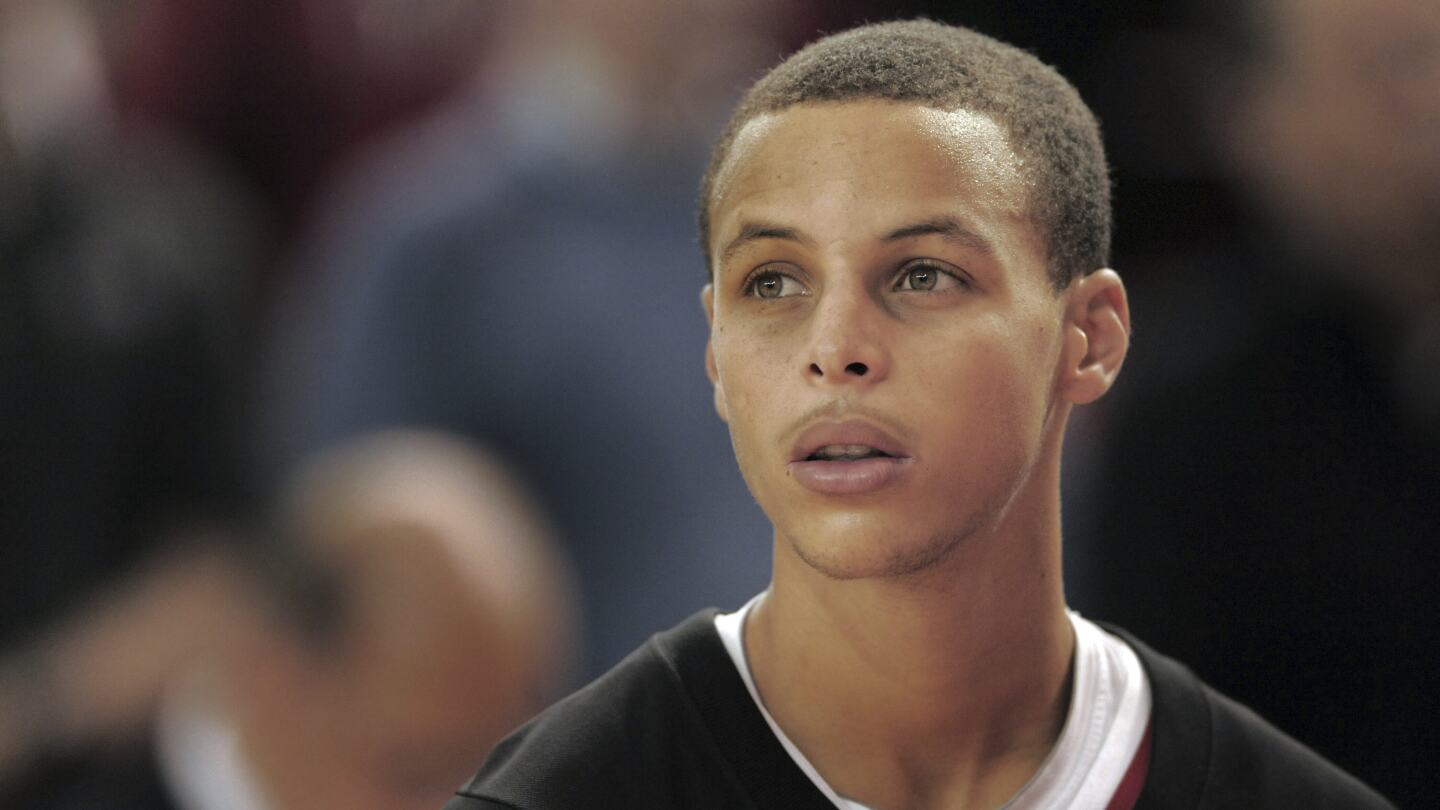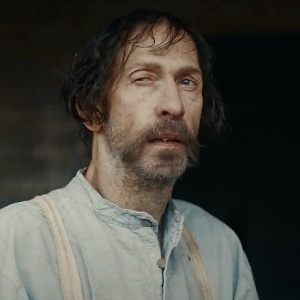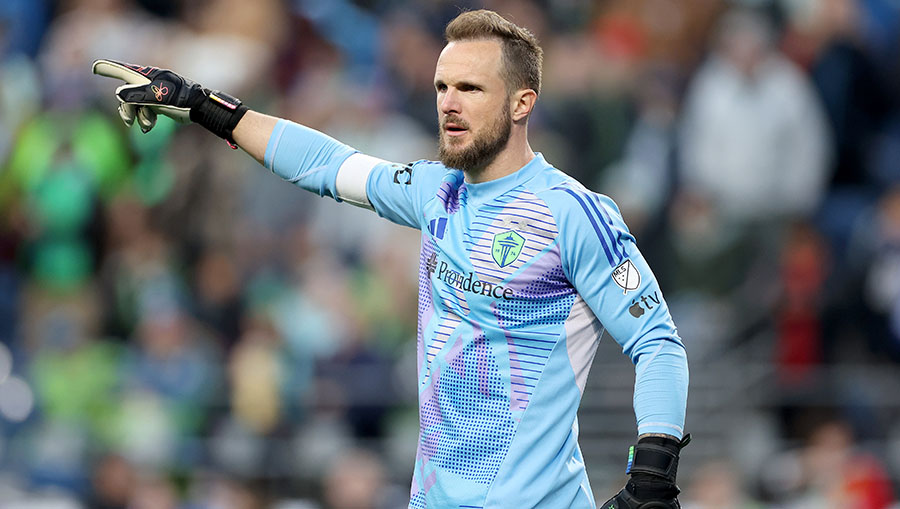Movie Reviews
Movie Review: The resilience of basketball star Stephen Curry explored in Apple TV+ doc

“ Stephen Curry: Underrated ” is easily one of the most inspirational movies of the year.
This is a portrait of a man — the greatest three-point shooter of all time — who has felt inferior playing the game he loves since he was a scrawny kid playing on his local under-10 team. It’s easy to roll your eyes at supermodels who say they were teased when they were kids or famous actors who look like the captain of the football team insisting they were outcasts in high school. In the rear-view mirror, when things have gone so well after that origin story, it just always rings a little false.
But in this documentary, directed by Peter Nicks and streaming on Apple TV+ Friday, the filmmakers put you in Curry’s shoes. They show you video of him on that under-10 team, indeed looking scrawnier than his counterparts and with the posture of someone who’s already self-conscious about it.
Stephen Curry took a four-point lead Friday in the American Century Championship celebrity golf tournament.

NEW YORK (AP) — Golden State’s Stephen Curry was selected as this season’s Kareem Abdul-Jabbar Social Justice Champion, the NBA announced Tuesday.

OAKLAND, Calif. (AP) — In an empty gym on a small campus deserted for spring break, one of the NBA’s top future prospects receives shooting guidance from coaches on Stephen Curry’s training team.
They have Reggie Miller on hand to read the draft report which says Curry is “far below NBA standard in regard to explosiveness and athleticism,” extremely short for a shooting guard position, and cautions “do not rely on him to run your team.” Ouch.
And they close in on his face at some of the biggest moments of his career, both in college and in the NBA, to show a reaction that’s neither smug nor nonchalant or overly celebratory: It’s authentic astonishment.
And as if to upend expectations even more, the present timeline of “Stephen Curry: Underrated” is not focused on a season or chasing a title — though there is plenty of basketball, including the moment he breaks the three-point record. It’s almost more about college — deciding he wanted to play at school, finding the right school for himself and, many years and championships later, studying to finish what he started, while juggling his career, his contracts and his family.
In 2009, Curry decided to leave Davidson College a year early, without graduating, to pursue professional basketball. But he made a promise his mother, Sonya, that he’d go back and finish at some point.
Curry and Davidson, like most healthy athlete-school agreements, seemed to choose one another at exactly the right time. When he got in, feeling good about himself, he went to tell his friends: They’d never even heard of the small liberal arts college in North Carolina. That was a bit disappointing but what would have been even worse is if he’d accidentally sabotaged the whole thing by not responding to coach Bob McKillop, who started to worry whether his recruit was being pursued by other schools when Curry went dark.
From high school to college on into the pros, something that struck many about Curry is how he makes a lot of mistakes but never seems to wallow in them. When he goes up against Michigan for the first time in college, he describes how everything that could go wrong went wrong. Later, his coach said he was going to start the next game. McKillop saw in his perseverance a toughness that was rare in players.
His parents, Dell and Sonya, helped shepherd that discipline but always because he wanted it — not some horrifying reversal in which the parents are the drivers of something.
You don’t need to know much about basketball or care about Steph Curry to watch this film, though many probably will. But much like the Michael Jordan doc “The Last Dance,” this beautifully constructed (and much more economical) narrative operates on its own terms, with a beautiful score guiding the viewer through his life.
As he says in a zen sort of way, he’s just, ”Trying to find the space to survey my life … Let my mind think about how I got here.”
“Stephen Curry: Underrated,” an Apple TV+ release streaming Friday, is rated PG-13 by the Motion Picture Association for “brief, strong language.” Running time: 110 minutes. Three stars out of four.
—-
MPA Definition of PG-13: Parents strongly cautioned. Some material may be inappropriate for children under 13.
—-
Follow AP Film Writer Lindsey Bahr on Twitter: www.twitter.com/ldbahr.

Movie Reviews
Movie Review – Old Henry

Read Time:3 Minute, 2 Second
If you’re hankerin’ to watch a western that flew under the radar, look no further than Old Henry, staring Tim Blake Nelson. This is an overall well-made movie. The only thing better than the writing is the acting and that’s because Tim Blake Nelson is one of the best, and most underrated, actors around these parts. 🙂
How long is the movie? Exactly as long as it needed to be and not a minute extra. The runtime is on the short side, at about 92 minutes. The pacing works perfectly, and every moment serves a purpose. That’s a rare feat these days.
——Content continues below——
The World’s Most Indispensable Movie App
The RunPee app tells you the best times to
run & pee during a movie
so you don’t miss the best scenes.


Download the RunPee app.
100% free (donation supported)
Read more about the RunPee app.
If you haven’t already seen the movie then please come back and drop me a comment after you see it. I’d love to know what others think.
Grade: A+
Analysis
[Spoilers ahead. Don’t read this if you haven’t seen the movie.]
What do we learn in the first scene with Henry, his son Wyatt, and the brother-in-law? Henry is a hard worker, and hard on Wyatt, but fare. Wyatt, is about as rebellious as a young man could be at this time and doesn’t like to work hard. The first thing we see Wyatt do is pick up a rock and put it in the cart to haul off. And he makes it seem like it’s the hardest thing he’s ever done, while his father is standing in a ditch chopping away with a pick-axe.
What’s the last thing we see Wyatt do in the movie? Haul a heavy rock up to the top of a hill to place on his father’s tombstone. No one told him to do it, he just saw that it needed doing. This is character development at its best. We have no idea what Wyatt will do with his life, but we have no doubt that he’s going to take the lessons he learned from his father, especially in the last few days, and make the most out of his life.
The Reveal
The reveal was deftly handled because it didn’t seem like there was anything to reveal, even though there were hints of it. If I paused the movie after each scene to analyze it, it may have been obvious from much earlier in the movie what the reveal would be. But the clues were subtle and covered up. Like trying to follow someone’s trail after a hard rain. The fact that the bad guys were following a trail may have just been part of the story, but it also serves the double purpose of telling the viewer that there is a trail being left throughout the movie that only an astute viewer might notice.
Writing
Potsy Ponciroli wrote and directed the movie. Potsy gave this script a great deal of tender loving care. This is an example of a script ready to be turned into a movie. I would love to talk to Potsy about the drafts that led up to this and how long it took for him to cut and trim everything just so. I feel confident that Potsy knew when there was nothing left to cut or polish in this script. It’s as near to perfect as any script can be. That doesn’t mean it’s the best movie ever. It just means it’s the best movie it could be.
Ratings
This movie has a 7.2/10 on IMDb. That’s not bad for an IMDb rating which I’ve noticed usually trends a little lower than ratings elsewhere. But I’m not sure why. At RottenTomatoes this has a 95% from the critics and 92% from the audience. That’s a little more like it.
Don’t miss your favorite movie moments because you have to pee or need a snack. Use the RunPee app (Androidor iPhone) when you go to the movies. We have Peetimes for all wide release films every week, including IF, Fall Guy, Kingdom of the Planet of the Apes and coming soon Furiosa: A Mad Max Saga and many others. We have literally thousands of Peetimes—from classic movies through today’s blockbusters. You can also keep up with movie news and reviews on our blog, or by following us on Twitter @RunPee.
If there’s a new film out there, we’ve got your bladder covered.
Creator and developer of the RunPee app. When something doesn’t work right in the app it’s pretty much his fault. 🙂
Aspiring author. Would like to finish his “Zombie Revelations” trilogy if he could break away for working on RunPee and the cottage he’s building for RunPee Mom.
Movie Reviews
‘It’s Not Me’ Review: Leos Carax’s Cinema Collage Mixes Movies, History and Real Life into a Personal Manifesto

After Jean-Luc Godard, Leos Carax is probably the French filmmaker most associated with the term enfant terrible. In some ways, he’s been even more terrible than Godard ever was, adopting a pseudonym (he was born Alex Dupont) as a teenager and bursting onto the scene at age 24 with Boy Meets Girl — Godard made Breathless when he was 30 — which immediately turned him into a major young auteur to be reckoned with.
He followed that up with the powerful, AIDS-inspired Mauvais Sang, and then made The Lovers on the Bridge, a film infamous for being a French Heaven’s Gate that went way over budget and flopped (it’s still a fantastic movie). After that Carax disappeared for a while, then reemerged to make a few shorts, compose pop songs and shoot a new feature every decade, the last one being the Adam Driver-Marion Cotillard starrer, Annette.
It’s Not Me
The Bottom Line A short and dense film autobiography suited for the auteur’s fans.
Venue: Cannes Film Festival (Cannes Première)
Cast: Denis Lavant, Nastya Golubeva Carax, Anna-Isabel Siefken, Bianca Maddaluno, Kateryna Yuspina, Loreta Juodkaite, Peter Anevskii
Director, screenwriter, editor: Leos Carax
40 minutes
His latest work, the medium-length, autobiographical collage It’s Not Me (C’est pas moi), is both that of an enfant terrible and a true-blooded Godard disciple. It mimics, or pays homage to, the late Franco-Swiss director’s montage films like Histoire(s) du cinéma and The Image Book, using the same colorful on-screen titles that JLG once used to comment on footage both old and new.
That footage was assembled by Carax for an exhibition meant to happen at the Pompidou Center a few years ago, but still yet to take place. (Back in 2006, Godard was asked to do his own show at the same museum, then abandoned it due to “artistic, financial and technical difficulties,” only to replace it several months later with what was best described as a “non-exhibition.“)
In preparation for the show, the organizers ask Carax a simple question: Who are you? The answer, according to It’s Not Me, it that he’s everything from silent movies to Hollywood Golden Age classics to scenes from his own work. He’s also the music of Nina Simone and David Bowie and The Fall, as well as Ravel and Beethoven. He’s Monsieur Merde (Mister Shit), a raving alter-ego played by Denis Lavant, who’s starred in nearly all of his films. And he’s above all a person who defines himself through the cinema, whether it’s the movies he loves or those he’s made throughout his turbulent career.
People unfamiliar with Carax’s oeuvre will likely be lost here, while fans and cinephiles will find a hearty meal to feast on. It’s Not Me is chock-full of references and influences, from F.W. Murnau to Jean Vigo to Godard himself, whose trembling voice is heard on a voice message he once left the director.
There are also scenes featuring Carax’s real family, including his daughter, the actress Nastya Golubeva Carax, whom we see skipping along the Seine in old cell phone footage, then marvelously playing piano in a scene illuminated by candles. The auteur himself appears a few times as well: at the very start, where he’s lying on something like his deathbed, and later walking through the Buttes-Chaumont park accompanied by Monsieur Merde, who gleefully runs down a hill and defecates in a bush.
The film jumps around so quickly that it’s sometimes hard to follow the director’s lead. At other moments Carax more succinctly expresses his views, such as in a rapid-fire montage of world leaders that groups together Putin, Trump, Kim Jong-il and Benjamin Netanyahu. Another scene provides a brief history of Roman Polanski’s tumultuous and controversial life, in what seems like a plea for his defense.
While Carax’s movies have never been overtly political or historical, this one makes several references to Hitler and the Nazis. In one sequence, the director cuts in footage of Isadore Greenbaum, the Jewish plumber who tried to interrupt a pro-Nazi rally held at Madison Square Garden in 1939. In a later scene staged by Carax — and shot by cinematographer Caroline Champetier, the DP of Holy Motors — a mother sits beside her children in bed, eerily reading a bedtime story that describes the Final Solution.
Again, it’s a hearty meal, and also a condensed one at only 40 minutes. The auteur seems to be squeezing everything he can into a personal manifesto in which cinema, history and real life become interchangeable, and in which he tries to situate his work within film’s larger trajectory. The most telling evidence of this is a sequence which cuts from Eadweard Muybridge’s pioneering photos of a horse in movement to a tracking shot of Lavant gloriously running and dancing down a Paris street in Mauvais Sang.
At such moments, it’s clear that Carax has not only reserved his own place in cinema’s trajectory, but that his films remain instantly recognizable through their romantic exuberance and visual splendor, their dark humor and existential gloom. These traits may not describe who Carax is or wants to be — if one is to believe that his latest movie is not, in fact, him (c’est pas moi). But they’re what we know and love about a great filmmaker, and still very much an enfant terrible at age 63, who’s always put the whole of himself into his work.
Movie Reviews
Black Dog: Chinese director Guan Hu makes Cannes debut

2.5/5 stars
Black Dog begins with all the trappings of a revenge Western. Set in a godforsaken town where bad guys roam around with impunity, it revolves around a reticent man returning home after a decade-long absence to confront his sworn enemies.
It also seems to have everything in place for a political allegory. Juxtaposing images of crumbling tenements with incessant radio news bulletins about the Beijing Olympics, the story, set in 2008, could offer commentary about the clash of reality and dreams in 21st century China.
As it turns out, Guan Hu’s film is neither. From the big bang of its first half-hour, Black Dog is slowly reduced to a whimper, as what was set up to be a hard-boiled genre film turns into a sentimental relationship drama about a wayward man’s attempt to connect with his family, friends, foes and his new four-legged buddy.
Settling into his long-abandoned home, his past returns to haunt him in the form of the local butcher, who accused Lang of having caused his nephew’s death.
But the bad guy in town is Yao (Jia Zhangke), the chain-smoking leader of a bunch of “dog management officers” who capture strays and steal pets in order to resell them elsewhere for a profit.
Lang joins Yao to earn some hard cash, only to find his humanity flickering back to life when he forms a bond with a raging, rabies-stricken hound. This inspires him to reconcile with his adversaries, his ailing zoo-master father and his younger self.
While there’s nothing wrong with Guan’s decision to steer a fatalistic tale towards a happy ending, the change of tone does Peng few favours, as he is forced to reprise the kind of gawky man-child role he has been typecast in for just too long.

Meanwhile, the flood of positive energy in the second half of the film renders its remarkable set design evoking doom and gloom irrelevant. The same can be said even of apparently important characters: Dong Liya’s circus acrobat, for example, is left with nothing to do as the prospect of forming a relationship with Lang evaporates.
The canines are cute, though – and for some, perhaps, that is Black Dog’s main draw.
-

 Finance1 week ago
Finance1 week agoSpring Finance Forum 2024: CRE Financiers Eye Signs of Recovery
-

 World1 week ago
World1 week agoIndia Lok Sabha election 2024 Phase 4: Who votes and what’s at stake?
-

 Politics1 week ago
Politics1 week agoBiden’s decision to pull Israel weapons shipment kept quiet until after Holocaust remembrance address: report
-

 News1 week ago
News1 week agoThe Major Supreme Court Cases of 2024
-

 News1 week ago
News1 week agoTornadoes tear through the southeastern U.S. as storms leave 3 dead
-

 World1 week ago
World1 week agoA look at Chinese investment within Hungary
-

 Politics1 week ago
Politics1 week agoTales from the trail: The blue states Trump eyes to turn red in November
-

 World1 week ago
World1 week agoBorrell: Spain, Ireland and others could recognise Palestine on 21 May







/cdn.vox-cdn.com/uploads/chorus_asset/file/25454244/Screenshot_2024_05_18_at_12.02.42_PM.png)











